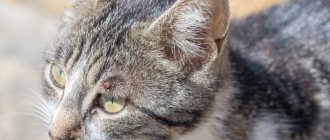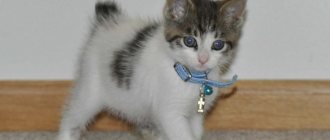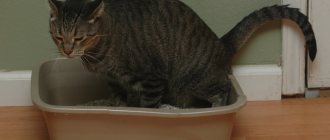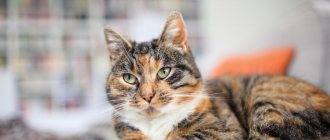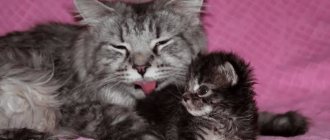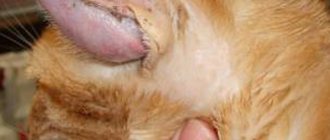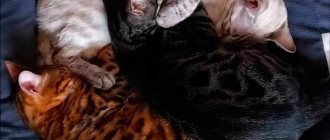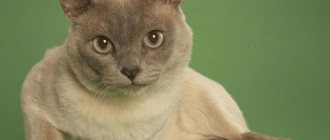British cats are pets that have won the hearts of true connoisseurs of beauty around the world. Among the British, there is a special group of colors that amaze with their beauty - chinchillas, smoky.
A unique feature of these colors is that the hairs on the cats’ coats are not completely dyed – only partially. The degree of coloring varies depending on the specific type. The rest of the hair, the undercoat, is pure white, silver or very light in color. This color option is usually called tipping. The attractiveness of this color is that the light coat is hidden under a brighter, base tone. When the cat moves, the effect of a smooth flow of one color into another appears.
The varieties of the British breed under consideration have their own characteristics and standards. When choosing a kitten or wanting to start breeding British cats (reviews from breeders state the fact that the chinchilla color is complex), you need to arm yourself with the relevant information. In this article you can find answers to many questions.
British chinchilla.
The British chinchilla is an artificially bred cat breed. It is a variety of the British one. The name speaks for itself - the fur of these cats is surprisingly similar to the soft, delicate coat of chinchillas. This color is one of the rarest and most expensive, but can be found among representatives of other cat breeds - Persian, as well as Burmese.
Scottish Fold SFS as blue smoke
The very first representative of the cat family with a unique fur coat was a cat named Shinny. Being British not only by the name of the breed, but also by origin, Shinnie was born in 1882. The parents were a Persian cat and a smoky-colored British cat. Further work on the development of the breed with amazing color was crowned with success; in 1889, another handsome cat appeared - a cat named Silver Lambkin. He was recognized as the ancestor of British chinchillas. Subsequently he won many awards and titles at international cat shows.
Variants of British chinchillas, description.
Since the chinchilla is a representative of the British, it has all the main characteristic features and standards of this breed. Chinchilla cats, like true representatives of the British breed, have a strong build and a large head. A striking feature of all British people is the dark rim around the eyes.
The pride of chinchillas, which sets them apart from other representatives of the British breed, is their luxurious fur. Quite short, has a dense structure, does not lie close to the body, and has a thick undercoat. The color of fur coats varies depending on the cat's color type.
Where does the British Golden Chinchilla live?
Photo: British Golden Chinchilla cat
As representatives of an aristocratic breed, cats need special living conditions. Before you get such a cat, you should think about whether you can provide him with the proper living conditions. A prerequisite for a comfortable existence is cleanliness and order. Another important criterion is the optimal room temperature. These cats are not intended to be kept in outdoor conditions. They cannot tolerate cold, so the room temperature must be at least 22 degrees.
Unlike other cats, they tolerate loneliness well, and even love it. The less people and attention there are for the Scots, the more comfortable they will feel. However, they require attention and participation from the owner in their life.
Coming home from work, the owner must take pity on his pet and pay attention to it. Be sure to keep your cat's ears clean. This is the weak point of representatives of this breed
Often, due to untimely cleansing, cats develop infection, suppuration, and infectious processes.
Such an aristocratic animal definitely requires personal space. In this regard, it is necessary to take care of the arrangement of the “house”. It is best if it is located in a secluded place, hidden from prying eyes. It cannot be said that golden chinchillas are demanding in terms of living conditions and care. However, there are some guidelines that you need to follow.
Animals' eyes should be wiped with a cotton pad moistened with boiled water. A weak solution of chamomile can be used as a solution. Cats need to brush their teeth once a day. Teeth cleaning is carried out with special hygiene products that are sold in veterinary pharmacies. Animals' nails should be trimmed at least once a month.
Health
Modern felinologists offer several options for the origin of British breed cats with the Golden Chinchilla color. American and British breeders are vying for the lead in the struggle to create the breed.
Despite all the differences in opinions, the fact remains undeniable that pets with a gorgeous golden hue to their skins have good immunity and resistance to adverse environmental factors.
Characteristics and color features
Regardless of the breed, chinchilla cats should have hair with a smooth color transition from soft pink to dark at the tips. The undercoat can be of different shades: from light peach to red. There should be no dull or grayish areas on the body.
The color is considered chinchilla if the dark tip occupies 1/8 of the length of the hair. If 1/3 is painted, the color is called shaded, if 1/2 is called golden tabby.
In chinchillas, the pigmentation of the iris is usually green or bluish-green. There is a dark brown or black edging on the eyelids, lips and nose. The lobe is colored pink, the paw pads are black or brown.
Information about the breed and color of the cat is indicated in the pedigree. Special designations are used for this.
Breed:
- BRI - British;
- PER – Persian;
- SFL – Scots Fold Shorthair;
- SFS – long-haired Scots Fold;
- SCS – Scots with erect ears, shorthair;
- SCL – long-haired, erect-eared Scotsman.
Color:
- y – golden;
- a – blue;
- b – chocolate;
- c – lilac;
- n – black;
- o– cinnamon;
- q – faun.
Picture code:
- 11 – shaded;
- 12 – chinchilla;
- 21 – linx (tabby pattern on the face and paws);
- 22 – marble;
- 23 – brindle;
- 24 – spotted;
- 25 – ticked (each hair has more than two dark zones);
- 33 – point (reminiscent of the Siamese color).
At the end they put numbers indicating eye color:
- 64 – green;
- 61 – blue;
- 62 – yellow.
For example, a Scottish fold short-haired chinchilla of golden color with black tips of hairs and green eyes would be written as follows: SFLny 12 64.
Scottish
The Scottish chinchilla cat has the same color as the British one. She has a plush coat, a dense undercoat of a warm shade, dark lining of the eyelids, lips and nose, and brown paw pads.
The eyes are most often green, but can also be blue. These animals have soft, rounded body shapes, which provide developed muscles and thick hair.
How to breed this breed
Only experienced breeders who are familiar with all the characteristics of the breed can engage in breeding. Breeding British chinchillas is difficult, since when close relatives are crossed, genetic changes occur that lead to the birth of rejected kittens.
Currently, breeders are working on new colors and improving the quality of the breed. The British chinchilla is still not considered 100% formed.
Choosing a partner
There are very few nurseries for breeding British dogs. Partners are selected carefully, after studying pedigrees. If the offspring will not participate in exhibitions, then the criteria for selecting a partner are less strict. For such mating, you can choose a pet with a slight defect in color.
When choosing a pair, the following criteria are studied:
- strict compliance with the breed standard;
- absence of any diseases;
- animal behavior;
- availability of all documents;
- presence of required vaccinations;
- absence of worms.
If the partner previously had offspring, then their quality should be studied.
First mating
Representatives of the breed are animals whose puberty occurs late. The first mating is allowed no earlier than 20-24 months. Early birth is dangerous for the health of the cat and the life of the offspring.
A British chinchilla can give birth no more than 1-2 times a year. If a cat does not have a break, the quality of the offspring will deteriorate greatly. Frequent childbirth can lead to exhaustion and death of the animal.
Video: Schoolgirls organized a shelter for dogs in the garden
If the name of a medium-sized nursery appears, albeit not often, but regularly, then this nursery deserves attention - it is clear that not all offspring are exhibited. It is difficult to judge a small nursery by the frequency of occurrence of its name.
In order to determine whether breed characteristics are being improved in a nursery and whether the general breed type of animals is changing, it is necessary to collect information about several generations. Occasionally, nurseries “post” their illustrated history on the website (and in these cases, as a rule, it is such that it allows breeders to be proud of their breeding work), but, alas, one cannot count on such a “gift”.
Try to find old photographs in show reports in magazines and yearbooks. You can also contact the breeder himself. If he is confident in the stable progress of breeding in the nursery, he will not refuse to show you photographs of the grandparents of his animals.
— the incidence of hereditary anomalies and diseases is an indicator about which it is most often impossible to collect reliable information. Unfortunately, we usually have to settle for gossip and rumors (often exaggerated).
Evaluation of a specific animal based on exterior and pedigree
With good knowledge, and, what is especially important, understanding of the breed standard, assessing the exterior of an adult animal and its belonging to a certain intra-breed type is not so difficult. Since ideal animals practically never occur (and if they do, a good breeder leaves them in his nursery), then, most likely, the animals offered for sale will have some shortcomings
It is very important to analyze the true nature of the proposed animal's shortcomings. Without this analysis, it is impossible to understand how to correct this deficiency in subsequent generations.
For example, if the ears of a British cat seem too large (relative to the standard), then they may be really large in size, or they may be quite average in size, but incorrectly set (for example, without the necessary forward tilt, which hides the size of the ear).
And incorrect positioning, in turn, turns out to be due, for example, to the too early end of growth of the skull bones.
Conditions of detention
Since silver chinchilla cats are very beautiful, they are not cheap. And in order to maintain their beauty and justify the money spent on their acquisition, it is necessary to periodically carry out some animal care procedures. The manipulations are simple, but they must be done regularly.
Chinchilla fur requires special attention. In order for it to really sparkle and shine with silver, it must be combed at least twice a week. This applies to both long-haired and short-haired breeds. First, the fur is combed in the direction of growth, then in the opposite direction. This procedure will not only keep the animal’s fur in order: combing is also an excellent massage, which is very useful for an aristocratic pet.
Washing your chinchilla often is not recommended. Water procedures are indicated for animals as needed. If soap is used too often, the natural fat layer is washed away, and the coat itself acquires an unaesthetic yellowish tint. To keep your chinchilla cat clean, it is recommended to use special dry shampoos for cats. Preference should be given to products with a whitening effect.
A feature of all chinchillas is increased tear production. Therefore, tear streaks appear often and need to be removed with a cotton swab dipped in a solution of boric acid, chamomile, or at least ordinary boiled water. If suppuration occurs, it can be cured with tetracycline ointment.
You should also not forget to take care of your cat's teeth. This should be entrusted to a veterinarian, who will also check their condition for possible diseases.
If there is an unpleasant odor coming from your pet's ears, you should also consult a doctor.
The animal's claws are trimmed twice a month. Ordinary scissors are not suitable; they can injure the animal. There are special nail clippers that can be used to trim nails to the desired length.
To consolidate the protection, a second vaccination is carried out after a month. Then vaccinations should be repeated annually. The incubation period for any vaccine lasts 10 days.
Persian
Persian chinchillas are slightly smaller than their counterparts. They are harmoniously built, distinguished by fine bones and elegance, but at the same time strong and resilient. In the USA, larger cats are bred, which are very similar in size and build to standard Persians.
The coat of Persian golden chinchillas is long and dense. The fur shimmers beautifully in the light. The cat may have emerald or bluish eyes with a brown rim. The soft pink nose is small and neat.
Castration and sterilization
If the animal will not participate in mating, and the owner does not want to produce offspring, then it is worth doing the procedure of sterilization or castration. It will protect the pet’s health and prevent accidental mating. It is recommended to castrate and sterilize individuals who were born in marriage or have genetic diseases.
The operation is allowed to be carried out at 8-10 months, when the animal’s body is fully formed
Before the operation, it is important to examine the British person, since deviations in health can lead to complications
Caring for your pet after surgery
After surgery, your pet will need special care that will reduce the risk of complications.
For several days after surgery it is recommended:
- limit the animal's mobility;
- provide comfort;
- do not frighten or torment your pet;
- do not feed for 10 hours after anesthesia;
- put on a special device to maintain the seams;
- treat seams once a day for 14 days.
If a Briton feels unwell, the stitches begin to get wet, the temperature rises, etc., then he must be taken to the clinic immediately.
Character
The golden tartan's favorite pastime is to be close to its family, actively participate in the owner's life, or just be nearby. Prefers any activity related to a person, but it does not get boring, requiring attention and affection.
She does not tolerate loneliness well; if she is left alone at home, she will get bored and seek companionship. The devotion of the golden Scottish cat is so great that after separation she will not take revenge on her owner, but will gratefully curl up at his feet.
The character of the Golden Scotsman is flexible, loving, compliant. A kind cat gets along well in a family, charms everyone, becoming everyone's favorite. He is friendly towards all family members, but he chooses one owner as his favorite, preferring to spend more time with him.
The Golden Scottish Chinchilla has an innate aristocracy. The animal will never scratch the furniture, climb the curtain, or go to the toilet past the tray. Behavior is mannered, gait is smooth, imposing, with a sense of self-esteem.
He is afraid of heights, so fragile things can be safely put on a shelf.
The Scottish chinchilla has intelligence, the ability to learn, and developed intuition. She observes what is happening, draws conclusions, and treats strangers selectively.
For children who do not offend her, she will be a friend. She retains her playful character until old age, is sociable, friendly, and not vindictive.
Cats of this breed are extremely active and curious. They love active games, happily chasing a ball or imitating “catching up” with a toy. Therefore, your pet needs to buy bright toys, balls, and artificial mice.
Need to know. The Golden Scottish Chinchilla prefers to live without the proximity of other living creatures. If birds, fish or small rodents live in the house, she may hunt them.
Description and requirements for the standard
Despite the differences in color, the British chinchilla cat, regardless of the color of its coat, has a unique body structure. Representatives of this elite breed are characterized by large round eyes, pronounced cheeks, dense coat texture and a medium-sized head with small, rounded ears. Chinchillas have a short and wide nose.
As for the build, the chinchilla cat is distinguished by its medium body size, squat shape, flat back and powerful short paws, on which there are tufts of hair between the toes. The tail is short in length.
According to accepted standards, the color of a silver chinchilla is white with darkened edges, which creates the effect of the presence of silver on the animal’s fur. Due to the slight covering of black fur, it appears that the cat is wearing a black veil that extends to the back, paws and tail.
- The coat of the rodent of the same name is of medium size, in contrast to the fur coats of the British, which are shorter and fluffier.
- The head is round with small ears.
- The body is strong and wide. The tail is half shorter than the body.
- The paws and nose are short and wide. The nose is light brown and slightly flattened. Despite the general similarity of all individuals, there is a difference between cats with a silver chinchilla color, it is indicated by the amber color of the eyes in some animals.
- All representatives of the species have large, round eyes.
Owner reviews
To get a complete picture of the breed, it would be a good idea to collect reviews from owners who are well aware of the advantages and disadvantages of British chinchillas.
Many of them note their excellent appearance. Not every breed can boast of such attractiveness. Plus, they look incredibly cute. The owners also note good health - with proper care, they rarely need to seek help from a veterinarian. A calm character and peaceful attitude towards children are perceived as additional advantages to the above.
True, speaking about the positive features of the breed, many also note the high cost - after all, this is an important disadvantage. And not every breeder likes a wayward character - many prefer more docile and obedient pets.
Concluding the article, we can say with confidence that the British chinchilla is an excellent breed. Willful and intelligent, friendly and beautiful, such a cat will become a faithful friend and decoration of any home.
What does the British golden chinchilla eat?
Photo: British Golden Chinchilla
Cats should be fed only fresh, high-quality food or ready-made balanced food specifically for cats. For nutrition to be balanced, the food must contain at least 35% protein.
You also need to count calories. This is not difficult if you use ready-made food as a source of nutrition. The average number of calories for one adult is 70 kcal per kilogram of live weight. It is also necessary to ensure constant access to fresh, clean water. It must be changed daily. It is better to pour bottled or filtered water into the bowl. You can’t exclude natural foods from your diet. If the diet is balanced, the animal will be healthy and active.
What is included in the animal’s natural diet:
- raw lean meat;
- boiled or stewed offal (liver, heart, lungs);
- sea white fish, which is cleaned of bones;
- dairy products with a low fat content (cottage cheese, yogurt without fillers, sour cream);
- two or three times a week you can give cats boiled eggs (preferably quail);
- boiled vegetables several times a week (preferably homemade vegetables - potatoes, carrots, potatoes);
- boiled porridge (buckwheat, rice, millet).
If the animal has silky, soft and shiny fur, then the cat is well-nourished, and its diet is filled with everything it needs. There is a list of products that are strictly contraindicated to be included in the diet of animals.
What is forbidden to give:
- canned food;
- smoked meats;
- sausages and sausages;
- hot, salty and spicy dishes;
- raw cow's milk;
- canned meat or fish.
This breed of cat is prone to overeating and obesity. In this regard, the owner must himself dose the amount of food required for the normal growth and development of his pets. It is better to feed them in small portions five to six times a day. Be sure to sow special cat grass in the autumn-spring period, which cats can nibble.
Now you know what to feed your British golden chinchilla. Let's see how to breed these cute cats.
Feeding the animals
For feeding golden chinchillas, like other purebred cats, high-quality ready-made food with a protein content of at least 30-35% is suitable. They have a balanced composition and fully satisfy the needs of the animal’s body.
The following brands have proven themselves well:
- 1st Choice;
- Hills;
- Acana;
- Leonardo;
- Sanabelle Bosch;
- Pro Plan.
If the owner chooses a natural diet, then it is based on meat - turkey, chicken, veal. The meat needs to be frozen for 2-3 days. It is given raw, cut into pieces and doused with boiling water. These measures are necessary to destroy parasites and bacteria.
Cats do not refuse offal. Liver, lung, heart, tripe are suitable for feeding. They must be boiled for several hours.
Also included in the diet:
- rice and buckwheat porridges;
- boiled sea fish fillet (if you have problems with the genitourinary system, this product is excluded);
- boiled vegetables (zucchini, carrots, pumpkin, cauliflower);
- egg yolk (no more than 2 times a week);
- fermented milk products with low fat content (kefir, yogurt, cottage cheese, natural yogurt).
Pets are fed 2-3 times a day. Food from the human table is contraindicated for animals.
Important. The structure and appearance of the coat directly depend on the quality of nutrition. Errors in feeding lead to dull and brittle fur and prolonged molting.
Nutrition
Veterinarians do not recommend mixing food from the common table and special food. It is optimal to focus on one option. At the same time, the pet’s diet should be quite varied. It is advisable to alternate between different types of meat: rabbit, chicken or turkey. As for cooking meat, there are no prohibitions - cats are equally loyal to both raw and cooked products.
Large pieces should be pre-chopped. In order to maintain shape, it is advisable to include fish and dairy products in the cat’s menu no more than twice a week. You should also not forget about vegetables - cabbage, carrots. You can add buckwheat, quail eggs, and oatmeal to your diet.
Description of the breed
At the end of the 19th century, the first kitten was bred with plush gray fur. The work was assessed as experimental. Then additional research and crossings began, as a result of which the official ancestor of the British chinchilla Silver Lambkin appeared.
Silver Lambkin
Silver participated in numerous exhibitions, where he was a repeated winner and prize-winner. The cat lived for 17 years.
Afterwards, work was carried out on the color of the animals' eyes. Breeders tried to achieve a beautiful emerald color; mixing led to the fact that the fur became worse. Initially, only light gray colors were recognized, which were called silver.
After the ideal silver cat was bred, breeders began to develop other colors. Later, golden chinchillas appeared. At the end of the 20th century, the species earned international recognition and was included in the official list of breeds with its own standard.
Appearance
The British Chinchilla standard corresponds to the characteristics of the British Shorthair cat. The main difference is the wool.
Representatives of the breed have a large body with a wide sternum, a straight back, and well-developed hips. The muscle corset is strong.
Breed standard:
- a large rounded head with a wide forehead and a neat rounded muzzle with wide cheekbones and pronounced round cheeks;
- the nose is wide, short and straight, the nose mirror is pink or brick colored;
- small rounded ears at the ends are spaced widely apart;
- the neck is short, thick and muscular;
- the eyes are large and round, set shallowly and not very far apart, the color is rich emerald green, but there are blue-eyed and yellow-eyed individuals;
- well-developed muscular limbs are proportional, but short, making cats appear squat;
- the paws are round, thick and large, with tufts of hair between the toes;
- the tail is not very long, thick, with a rounded tip;
- weight: male - 5-8 kg, female - 3-4 kg (castrated or sterilized individuals can reach 10-12 kg).
The coat should be dense and dense, the undercoat should be well developed.
Character of the breed
Representatives of the breed do not like to obey. They can become attached to the owner, but they always put themselves in the same place with him. The animal is calm, prefers to observe the situation from the side, and intervenes only if necessary.
Pets are quite capricious, do not like excessive affection, and prefer to spend time alone. They are easy to train and quickly get used to the tray. The British almost never play pranks in the apartment and do not damage furniture or wallpaper.
Cats are characterized by slowness, thoroughness, and patience. The animal will not ask for food at the wrong time and wake up the owner unnecessarily.
Colors
There are three main colors of the breed.
Silver or silver is considered classic and is most common. The ground color is white, and the undercoat is black at the tips. Darkening occurs on the sides, back, and tail. The muzzle (eyes and nose) is outlined with a thin black outline, the paw pads are dark.
The golden color is distinguished by the presence of a golden-colored undercoat. The color is even, without spots, all color transitions are smooth. Shading occurs on the tail and back. The belly and chest are distinguished by a light apricot hue.
The shaded color differs from silver in having a darker undercoat and the presence of large dark spots. There are dark stripes on the paws and tail; there are no pronounced transitions on the body.
Experts also distinguish ticked colors (merle). Chinchillas can have this color mainly in golden color. Such individuals have bright blue or blue eyes, and their character is more impulsive.
Breed health
Cats have strong immunity and rarely get sick; if they are improperly bred or crossed with closely related individuals, genetic abnormalities appear.
The most common diseases:
- retinal atrophy;
- polycystic kidney disease;
- thickening of the wall of the cardiac ventricle.
In the presence of genetic abnormalities and hereditary diseases, individuals are excluded from breeding and are considered defective.
Diseases
Description of how to properly care for a chinchilla. This is the key to the longevity of a pet.
However, the breed from birth has a predisposition to:
- hypertrophied cardiomyopathy;
- obesity;
- retinal atrophy;
- polycystic kidney disease.
Sometimes there are problems with the respiratory system, teeth, and skin diseases. The cat must be vaccinated from the first months of life. Mandatory injections for a number of diseases are given annually.
Where and how much to buy a British breed kitten
- In Moscow, British shorthair kittens can be bought at the SunRay nursery. On the nursery website https://www.sunny-cat.ru/ you can see photos of available kittens, book a kitten and find out any other information.
- In Minsk, British kittens are offered by the Krembel nursery creambel.com
- In Kyiv you can buy a British kitten in the cattery “Devinore*UA” www.devinor.com.ua
- Complete list of British Shorthair catteries (in Ukraine and Russia).
The price of British Shorthair kittens may depend on the class of the pet, coat color, prestige of the nursery, and city. You can buy a British kitten “hands-on” for 1,000 rubles, but in a nursery it will be more expensive – from 2,500 to 60,000 rubles. Please note that you can be sure that your pet is purebred only by purchasing it from a certified nursery.
Video
https://youtube.com/watch?v=3Sy9Mkkh0o0
